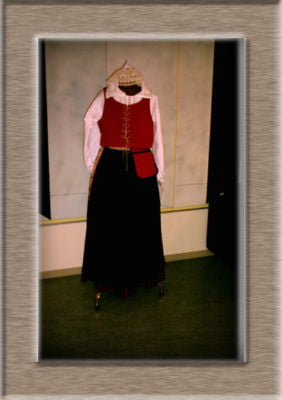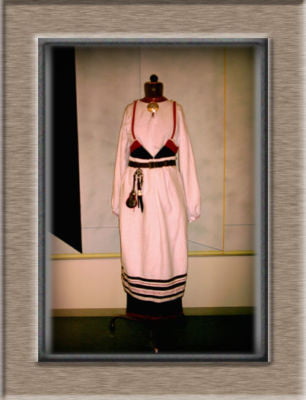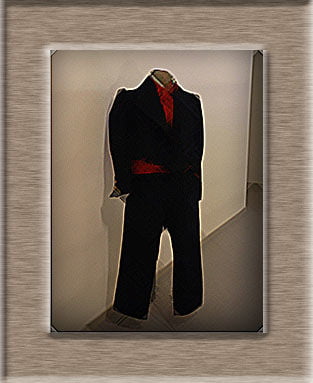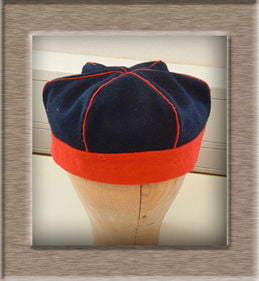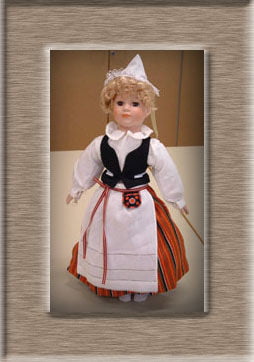This website was made as a course assignment at the Savonlinna Department of Teacher Education in spring 2004. This website was created mainly for the use of students and teachers and also for those who are interested in the Finnish national costumes.
Made by: Jonna Lahti, Heidi Lyyra & Arja Miettinen
History of Finnish national costumes
The origins of the national costumes
The Finnish national costumes are based on the outfits of common people in the end of the 17th and the beginning of the 18th century in Finland. These outfits used to represent the estate of the wearer and the higher class you were the more decorative your outfit was allowed to be. There were dressing laws which forbade dressing too sophisticated if one was not in upper class. Common people therefore had to come up with ways to dress well without breaking the laws. These laws influenced a lot the dressing of common people and the way the Finnish national costumes look today.
Putting together the national costumes
Finns got interested in their own culture in the 19th century and learned people started to travel around Finland and collect folk tradition. At that time Finnish culture was idealized in the society and that also had political intentions. Upper class decided to put together traditional costumes of common people and then started to call them the national costumes, kansallispuvut. In the 19th century the national costumes used to be sort of a hobby to the upper class but already in the 1930's the Finnish national costumes were worn by all the people.
The national costumes today
During the years the Finnish national costumes have changed in the way they look and at times they hardly resembled their prototypes anymore. This was caused by the impact of artists, development of sewing techniques, post-war time in the 1940's and 1950's, fashion, industrial production of the costumes and commercialism.
In 1979 Suomen Kansallispukuneuvosto, The National Costume Council of Finland was founded. It is responsible for researching, recording, documenting, educating, giving advice on, maintaining and developing the tradition of Finnish national costumes. The national costumes made today are as much as possible like their prototypes from the 18th and 19th centuries. Attention is paid to materials, sewing techniques, forms, colours, structures, patterns and cuts of the costumes. Any new costume put together today is based on thorough research and those costumes that already exist are corrected and modified to reflect their prototypes more accurately if that is necessary.
The regional differences of the Finnish national costumes
Finland has always been the meeting point of the western and eastern culture. Because of this history, there are also some clear distinctions between the western and karelian or also called eastern costumes. This regional variation can be seen the most clearly in women's apparel.
West Finnish costumes
West Finnish folk were in close connection with the Central Europeans and so the European trends were also carried to Finland. The western folk wanted to use colourful cloths and using cloth a lot was in fact considered to be a sign of wealth.
The West Finnish woman's costume typically features shirts with broad sleeves and stand-up or turn-up collars, massive skirts, laced bodices and short jackets, both with skilfully made drapes. The approns are often made of fabrics of one colour or decorated fabrics with vertical stripes or printed patterns. The headdresses are called a tanu cloth cap, a tykkimyssy silk cap, a hornshaped cap and a shaped bonnet. Girls generally wear a red silk headband.
Karelian costumes
In Karelia people lived in strained and severe circumstances and that reflected naturally in the way of dressing. Cloth was been used more sparingly than in the western parts of Finland but the Karelian dressmakers compensated that with lavish and colourful embroidery and with traditional lacework.
Women's skirts are generally darker than the West Finnish skirts and they are often made of woollen or half-woollen cloth. Shirts are usually decorated with embroidery and bodices have more simple drapes than the western ones. The aprons are decorated with horizontal stripes, embroidery, ribbons, fringe or lace. The outer clothing differs quite much from the western one. Karelian coats have straight and simple cuts and they are made of linen or coarse wool.
Parts of the Finnish national costume
Costumes for men
National costumes for men include white linen or cotton shirts with long sleeves and woolen trousers called luukkuhousut. There is no zipper in front but instead a panel with buttons. Trousers can be long or knickers. The costumes also include vests and short jackets called röijy or coats. With some costumes men wear belts, scarfs and hats of many kinds.
Hats for men
In West Finnish costumes:
- lippalakki: a cap with hard peak in front
- pellilakki: a cap made of several pieces
- varraslakki: a knitted, pointed hat
- silinteri: a top hat
- kairalakki: a scullcap, round hat made of six pieces without the peak
In Karelian costumes:
- huopalääppä: a tall felt hat with ribbon and tin decorations
- hylkeenpyytäjän lakki: "seal hunter's cap", a knitted hat
Costumes for women
National costumes for women consist of several parts and there are many differences between Karelian and West Finnish costumes. Headgear may change according to the region, age, marital status and even religion of the person. In general, all costumes include shirts, skirts, vests, short jackets called röijy or coats and headgear. Some costumes may include also aprons, belts, scarfs and pockets tied with ribbons or cords around the waist.
Shirts are white and long with long, wide sleeves. They are made of cotton, linen or of a mixture of these two. The neckline can be rectangular with collar or small, round and with no collar depending on whether the dress is from the West Finnish or Karelian tradition. In some Karelian costumes the shirt is decorated with a front panel called rekko which is highly embroidered with a variety of colourfull stitches. Usually all the shirts are decorated with stitches of different kinds around the neckline and wrists.
Skirts are long and usually made of wool. They are folded in different ways and often colourfully striped. In some Karealian costumes the skirts are of one colour with a narrow stripe of felt or ribbon of different colour sewed to the hem.
Vests are made of wool, linen or cotton. In West Finnish costumes the vests are thight and short with buttons or lace-ups and they can be made of a variety of different fabrics:
- verka: broadcloth, woolen fabric
- floretti: a flowery woolen fabric
- kalminkki: striped and shiny woolen fabric with satin weave
- parkkumi: striped fabric with wool as woof and linen as warp.
In these vests there are often folds at the back called körtit. Vests in Karelian costumes are more loose and simple. In some costumes the vest is attached to the skirt forming a dress called hartuushame.
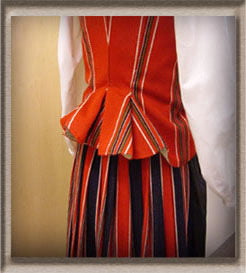
Körtit at the back of the vest in Pornainen costume
Aprons are strongly divided between east and west. In West Finnish costumes the aprons are made of cotton, linen, silk and karttuuni which in American English is known as calico: a cotton fabric with patterns printed on it. The aprons are vertically striped or of one colour. Karelian aprons are not as luxurious in the terms of materials used but a lot of creative thinking was used to make them look beautiful. The fabric used was usually home weaved cotton or linen and the the aprons were embroidered and decorated with laces of different kinds to form horizontal stripes. Also, in some costumes the aprons were decorated with patches of silk sewn to the hem.
Outer garments: röijy, kostuli, sarkaviitta
Röijyt are short jackets worn over vests and these are found mostly in the West Finnish costumes. They are long sleeved and made of wool or cotton. In some costumes there is the same kind of structure at the back of the röijy as in some vests: the folding called körtit.
Kostuli replaces the outer garments in Karelian costumes. It is made of linen and is therefore used mainly during summer by women and men and is decorated with embroidery and laces.
Sarkaviitta is made of wool and is used as winter wear by both women and men. It can be decorated with embroidery and pieces of chamois.
Headgear for women
Headgear has a significant role in distinguishing differences between east and west, young and old. With West Finnish costumes girls wear red silk ribbons around their head. Adult women wear tanu or liinalakki which is a linen hat with lace. Women can also wear tykkimyssy which is a small paper hat covered with embroidered silk. Under the hat is worn a lace called tykki.
With Karelian costumes Lutheran wifes wear different kinds of veils according to the costume: they can be small like buttons or long white cloths. Orthodox wifes wear sorokka/harakka which is a kind of small scarf worn over head and covering hair. It has embroidered part in front and it is tied behind the neck. Young girls wear säppäli, a ribbon of felt with tin pins or pinteli, a wide ribbon around their head. Women and young girls can both wear sykerö which is a structure made of praids of hair covered with ribbons.
Jewelry, fasteners and other stuff
West:
- helysolki: a brooch with small hanging jewelry
- levyriipus: a silvery necklace with plates
- shoes: shoes with buckle, dark laceshoes, pumps
East:
- paljinsolki: a round brooch to close the split in shirt necks
- cords or ribbons are used to tie up skirts, aprons, pockets, short jackets...
- shoes: dark laceshoes, lipokkaat which are leather shoes with a picot
- tuppivyö: men have knifes with sheath hanging from a belt decorated with a buckle and brass fittings.
Here is a collection of pictures of national costumes and details.
Using and caring of the Finnish national costume
The Finnish national costumes can be worn in all social occasions, even funerals. It is important that each Finnish national costume is an entity with all parts that belong to it. So for example earrings, if they don't belong to the costume, are forbidden. Baskets or bundles can be used as hand-bags.
The best caring is to use the national costume a lot. Besides that, it is good to air the costume from time to time. The cotton/linen shirts and aprons need to be washed after each use, but iron them only just before the next time you are wearing them. Woollen vests and skirts should not be washed very often in water. If the costume is however washed, that should be done in loose water. The costume should be kept in a cotton mothproof bag or in a big box.
List of exercises
Here are some exercises that test your knowledge of national costumes. Exercises are meant to be printed. You can first look them through and then print the ones you want to use. Many exercises are pdf -documents. Answers for the exercises.
Which is Which?
Join the words with their explanations.
| 1. Sorokka | A) Folds at the back of short jackets and vests in West Finnish costumes. |
| 2. Säppäli | B) A tall felt hat with ribbon and tin decorations. |
| 3. Silinteri | C) A felt ribbon with tin pins for young girls in East Finnish costumes. |
| 4. Huopalääppä | D) A kind of small scarf with embroidered front, worn by Orthodox wifes. |
| 5. Kärtit | E) A brooch with small hanging jewelry. |
| 6. Helysolki | F) A top hat for men |
Regional differences 1
Where are these costumes from?
Regional differences 2
Where are these parts of costumes from? Join the parts to the map in the right region.
Join the dots
Join the words with the help of hints.
Choose the right words
Choose the right word from the alternatives.
With these exercises you can increase your knowledge about national costumes and also use your creativity. You don't need to print them, but you do need some paper, crayons and other stuff.
Exercise 1
Talking about the national costumes
Here your task is to discuss about Finnish national costumes. There are some helping questions with each of the slide to get the discussion started. Some of the questions require looking for extra information.
Exercise 2
In this exercise your job is to invent new parts for national costumes.
National costumes have parts that have funny names and some even look funny. Now imagine and invent new parts, for example head dress, shirts, skirts, trousers, pockets... They can look funny or they can look like the real parts. Think what colours they would be, what shape and what names would they have. You can invent only few parts or compile a whole costume from the designed parts. Give your part a name and draw it on a piece of paper. And don't forget to use your imagination!
Exercise 3
Design your own fashionable clothes and accessories
Fashion gets often inspiration from tradition. Here your task is to design clothes and accessories using ideas from the national costumes.
You can start with considering the following matters:
- First think about what you want to design. Is it a garment or some accessory?
- Who will use your product?
- Think about what features of national costumes you want to use in your product.
- Develope the idea you want to use.
- Combine your developed ideas to the product.
Make a poster or some other presentation of your product. Make sure that the following information can be found there.
- Present the development of your ideas from the chosen features to the final product.
- Draw the product and colour it.
- Write down how the ideas from the national costumes are shown in your product.
You can also complete your design to a real product.
Hints for teachers
Usage of this website
This website is meant to be used at teaching arts and crafts, mainly for classes 5. - 9. There is information, pictures, exercises and hints to help teaching in this website. Site can be used in independent working and studying or in co-operative learning.
In information-section there is basic information about Finnish national costumes. Subject has been presented widely and it can be dealt in groupworks and presentations or students can independently get into their areas of interest.
In picture-section there is a pdf -presentation of visualizing pictures about Finnish national costumes and their parts. Pictures can be discussed together considering for example the regional differences presented in costumes or sewing techniques in different parts.
In exercise -section there are different kinds of exercises for students. Exercises for example guide the students to use their creativity, to increase their knowledge and to discuss about the Finnish national costumes.
Hints about what and how to teach
Here are some hints and links about what and how to teach the Finnish national costumes.
There are quite a lot of embroidery used in the Finnish national costumes. Students can first get to know different kind of embroidery (different techniques, colours, patterns etc.) used in the costumes. They can then use them as a starting point and design their own patterns and designs for some embroidery work (tableclothes, clothes, bags etc.). Traditional techniques can be used or apply new/modern techniques.
Making pockets
Pockets are a common part in many Finnish national costumes and women have used small left over pieces of fabric in making them. Today we can also design new pocket models and use them as acessories in our outfits. Small pieces of fabric can be used in them, so also recycling point of view can be added to this task. Students can design pockets, what colours they use there and how they are decorated, and then sew.
National costumes for dolls
To do a Finnish national costume takes a lot of time since all the seams are hand sewn. On the other hand, sewing a national costume for a doll doesn't take that much time and students get to know certain costumes and their parts as well as the sewing techniques used in national costumes. And the doll will look really nice with his/her new dress.
National costumes as applique figures
Students could also start with getting to know to different kinds of Finnish national costumes and then combine that knowledge to hand or machine applique. Students could choose either whole costumes or singular parts of those for their applique works. Applique can be used for example in some furnishing textiles such as cushion or tapestry.
Making ribbons
Ribbons are an essential part of the Finnish national costumes. They are made with different techniques and from different materials. Ribbons can be used in many ways, even today. Students can get to know different techniques and then design and make their own ribbons. They can use them as belts, bookmarks, decoration, bagstraps etc. Possible techniques are for example pirtanauha, lautanauha, solmeilu, iskuhapsut etc. They can be also embroidered or decorated some other way.
https://punomo.fi/pienta-kivaa/nauhat-nyorit/pirtanauha-miia-helena/
https://punomo.fi/tekniikat/nauhat-ja-nyorit/lautanauha/lautanauha-2/
Links to other websites
The National Costume Center of Finland -Suomen Kansallispukukeskus
http://www.craftmuseum.fi/english/nationalcostumecenter/index.htm
Answers for the exercises
Which is which?
1-D , 2-C, 3-F, 4-B, 5-A, 6-E
Regional differences
Costumes from left to right: Karelian - West Finnish - Karelian
Explanations: e.g. the decorations in the approns, headdresses, vests and outer clothing.
Choose the right word
Luukkuhousut - Rekko - Tanu - Paljinsolki
BACK: Exercises


